Synopsis
The Altercatio begins with a first-person introduction establishing a courtroom setting where two ladies will dispute the rightful inheritance of God's promises in the Old Testament. The rest of the work consists of the back and forth comments of the litigants, the Church (Ecclesia) and the Synagogue (Synagoga).
First, Synagoga argues that the prophets were sent to her, but Ecclesia responds that she killed them. Synagoga then argues that she is the more ancient, but Ecclesia responds that there has been a reversal of roles and the elder now serves the younger, as Esau served Jacob. This leads to a debate about the status of Jews in the Empire, with Synagoga defending her freedom and Ecclesia point to her loss of full civil rights.
Synagog argues that even Jesus was sent to the Jews, but Ecclesia retorts that the Jews are all the more culpable for having rejected him. She does not levy the standard accusation of Jewish deicide. The text then turns to the question of circumcision versus the sign of the cross with reference to the Prophets. At the end, Synagoga admits that she did not heed the Prophets and misinterpreted them.
Manuscripts and editions
The Altercatio appears to have travelled from North Africa to Spain, then across the Pyrenees to Gaul and finally across the Alps into Italy. There are at least twelve surviving manuscripts and three lost ones. The ninth, eleventh and twelfth centuries have three manuscripts each. The latest manuscripts are from the fifteenth century. The earliest known manuscript, now lost, was catalogued at the Abbey of Reichenau in 835–842. The earliest surviving copy is found in Munich, Bayerische Staatsbibliothek, CLM 15819, copied in Salzburg during the archiepiscopate of Liupram [ de ] (836–859). This is slightly older than the copy found in Saint Gall, Stiftsbibliothek 132, copied during the abbacy of Grimald (850–872). All the surviving manuscripts belong to a single family (descended from a single hyparchetype of about the eighth century), with the exception of manuscript 247 from Monte Cassino, copied in Beneventan script in the twelfth century. The former manuscript family attributes it to Augustine of Hippo.
Prior to 1955, the Altercatio was printed many times, always printed with Augustine's works. The editio princeps was printed by Bonifacius Amerbach in Basel in 1506 as part of Augustine's works. It was reprinted with minor changes by Erasmus in 1528. He already recognized that it was not by Augustine. Today, it is universally regarded as pseudo-Augustinian. A critical edition based on all known manuscripts was published by Jocelyn Hillgarth in 1999. The Altercatio is usually cited by Hillgarth's line numbers. [19] A full English translation of Hillgarth's edition was made by Michael Brinks in 2009.
Ambrosiaster or Pseudo-Ambrose is the name given to the unknown author of a commentary on the epistles of Saint Paul, written some time between 366 and 384 AD. The name "Ambrosiaster" in Latin means "would-be Ambrose". Various conjectures have been made as to Ambrosiaster's true identity, and several other works have been attributed to the same author, with varying degrees of certainty.

Augustine of Hippo, also known as Saint Augustine, was a theologian and philosopher of Berber origin and the bishop of Hippo Regius in Numidia, Roman North Africa. His writings influenced the development of Western philosophy and Western Christianity, and he is viewed as one of the most important Church Fathers of the Latin Church in the Patristic Period. His many important works include The City of God, On Christian Doctrine, and Confessions.

The Septuagint, sometimes referred to as the Greek Old Testament or The Translation of the Seventy, and often abbreviated as LXX, is the earliest extant Greek translation of the Hebrew Bible from the original Hebrew. The full Greek title derives from the story recorded in the Letter of Aristeas to Philocrates that "the laws of the Jews" were translated into the Greek language at the request of Ptolemy II Philadelphus by seventy-two Hebrew translators—six from each of the Twelve Tribes of Israel.

Cyprian was a bishop of Carthage and an early Christian writer of Berber descent, many of whose Latin works are extant. He is recognized as a saint in the Western and Eastern churches.
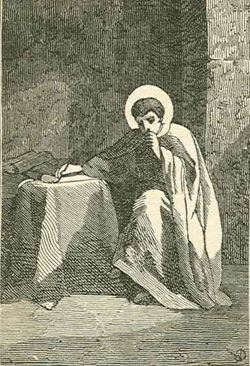
Prosper of Aquitaine, also called Prosper Tiro, was a Christian writer and disciple of Augustine of Hippo, and the first continuator of Jerome's Universal Chronicle.

The Johannine Comma is an interpolated phrase (comma) in verses 5:7–8 of the First Epistle of John.
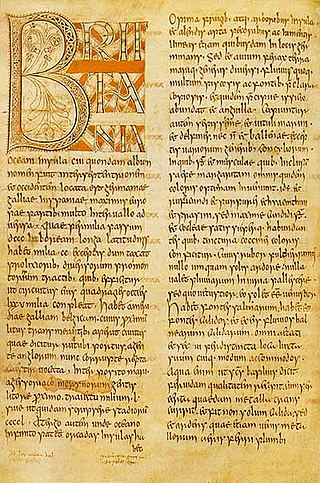
The Ecclesiastical History of the English People, written by Bede in about AD 731, is a history of the Christian Churches in England, and of England generally; its main focus is on the conflict between the pre-Schism Roman Rite and Celtic Christianity. It was composed in Latin, and is believed to have been completed in 731 when Bede was approximately 59 years old. It is considered one of the most important original references on Anglo-Saxon history, and has played a key role in the development of an English national identity.
A martyrology is a catalogue or list of martyrs and other saints and beati arranged in the calendar order of their anniversaries or feasts. Local martyrologies record exclusively the custom of a particular Church. Local lists were enriched by names borrowed from neighbouring churches. Consolidation occurred, by the combination of several local martyrologies, with or without borrowings from literary sources.
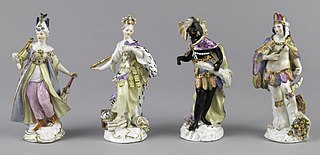
Personification is the representation of a thing or abstraction as a person. It is, in other words, considered an embodiment or an incarnation. In the arts, many things are commonly personified. These include numerous types of places, especially cities, countries, and continents, elements of the natural world such as the trees or four seasons, four elements, four cardinal winds, five senses, and abstractions such as virtues, especially the four cardinal virtues and seven deadly sins, the nine Muses, or death.

Ildefonsus or Ildephonsus was a scholar and theologian who served as the metropolitan Bishop of Toledo for the last decade of his life. His Gothic name was Hildefuns. In the Ethiopian Orthodox Tewahedo Church he is known as Dexius based on the Ge'ez translation of legends about his life.
Anti-Judaism describes a range of historic and current ideologies which are totally or partially based on opposition to Judaism, on the denial or the abrogation of the Mosaic covenant, and the replacement of Jewish people by the adherents of another religion, political theology, or way of life which is held to have superseded theirs as the "light to the nations" or God's chosen people. The opposition is maintained by the appropriation and adaptation of Jewish prophecy and texts, and the stigmatization of the very people who transmitted those texts. According to David Nirenberg there have been Christian, Islamic, nationalistic, Enlightenment rationalist, and socio-economic variations of this theme.

Pseudo-Cyprian is the conventional designation for the anonymous authors of Latin works falsely attributed to Cyprian of Carthage. These works do not have a common transmission history. Most are not forgeries, but were texts mistakenly attributed to Cyprian from an early date in their transmission. In many cases the works were taken to be authentic until modern times.
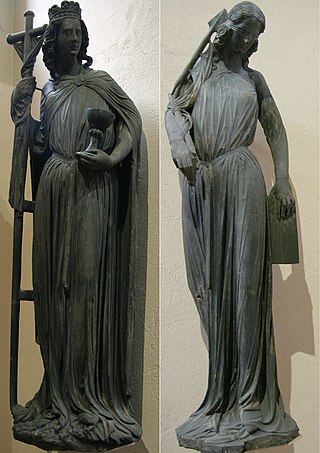
Ecclesia and Synagoga, or Ecclesia et Synagoga in Latin, meaning "Church and Synagogue", are a pair of figures personifying the Church and the Jewish synagogue, that is to say Judaism, found in medieval Christian art. They often appear sculpted as large figures on either side of a church portal, as in the most famous examples, those at Strasbourg Cathedral. They may also be found standing on either side of the cross in scenes of the Crucifixion, especially in Romanesque art, and less frequently in a variety of other contexts.
The Collationes in Hexaemeron are an unfinished series of theological lectures given by St. Bonaventure in Paris between Easter and Pentecost 1273.

The Ecclesiae Regimen, also Remonstrance, xxxvii Conclusiones Lollardorum, or Thirty Seven Articles against Corruptions in the Church, is a church reformation declaration against the Catholic Church of England in the Late Middle Ages. It had no official title given to it when written and the author(s) did not identify themselves in the original manuscript. This public declaration by the English medieval sect called the Lollards was announced to the English parliament at the end of the manifesto Twelve Conclusions of the Lollards published in 1395.

The term "Great Church" is used in the historiography of early Christianity to mean the period of about 180 to 313, between that of primitive Christianity and that of the legalization of the Christian religion in the Roman Empire, corresponding closely to what is called the Ante-Nicene Period. "It has rightly been called the period of the Great Church, in view of its numerical growth, its constitutional development and its intense theological activity."
The Bobbio Missal is a seventh-century Christian liturgical codex that probably originated in France.
Robert of Bridlington was an English clergyman and theologian who was the fourth prior of Bridlington Priory. He held the office during the period from 1147 to 1156, but it is not clear if he died in office or resigned before his death. Besides holding monastic office, he wrote a number of commentaries on biblical books as well as other treatises. Not all of his works have survived to the current day.
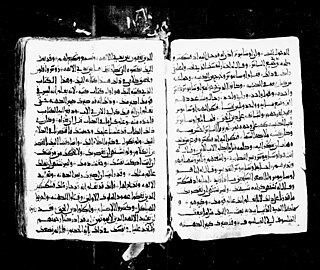
The Julian Romance is fictionalized prose account of the reign of the Roman emperor Julian the Apostate. It was written sometime between Julian's death in 363 and the copying of the oldest known manuscript in the sixth century. It was probably written in Edessa in Syriac, the language of all surviving copies. An Arabic adaptation had been made by the tenth century.

The Altercatio Hadriani Augusti et Epicteti philosophi is a Latin language question-and-answer dialogue composed by an anonymous author in the 2nd or 3rd century. It consists of a short, fictional conversation between Emperor Hadrian and the Stoic philosopher Epictetus. In its earliest form it consists of seventy-three questions on matters of wisdom and natural phenomena posed by Hadrian and answered by Epictetus. The emphasis throughout is on witty, riddle-like answers rather than philosophical ones.














